Structured Query Language (SQL) is a powerful domain-specific language used for managing and manipulating relational databases. Here are some key aspects of SQL:
1. Database Management Systems (DBMS):
– SQL is used to interact with relational database management systems (RDBMS) like MySQL, PostgreSQL, SQLite, Microsoft SQL Server, and Oracle. Each RDBMS may have slight variations in their SQL implementation.
2. Data Definition Language (DDL):
– DDL statements are used to define, modify, and delete database structures. Key DDL commands include:
– `CREATE TABLE`: Defines a new table.
– `ALTER TABLE`: Modifies an existing table structure.
– `DROP TABLE`: Deletes a table.
3. Data Manipulation Language (DML):
– DML statements are used to retrieve, insert, update, and delete data in a database. Key DML commands include:
– `SELECT`: Retrieves data from one or more tables.
– `INSERT`: Adds new records to a table.
– `UPDATE`: Modifies existing records in a table.
– `DELETE`: Removes records from a table.
4. Data Query Language (DQL):
– DQL is a subset of SQL focused specifically on querying data. The primary DQL command is `SELECT`, which retrieves data from one or more tables based on specified criteria.
5. Data Control Language (DCL):
– DCL statements are used to control access to data within the database. Key DCL commands include:
– `GRANT`: Provides specific privileges to database users.
– `REVOKE`: Removes specific privileges from database users.
6. Data Integrity:
– SQL supports the enforcement of data integrity constraints to maintain the accuracy and reliability of the data. Common constraints include:
– `PRIMARY KEY`: Ensures uniqueness of a column in a table.
– `FOREIGN KEY`: Establishes a link between two tables.
– `CHECK`: Validates values in a column based on a specified condition.
– `UNIQUE`: Ensures that all values in a column are unique.
7. Joins:
– SQL enables the use of joins to combine rows from two or more tables based on a related column between them. Common types of joins include INNER JOIN, LEFT JOIN (or LEFT OUTER JOIN), RIGHT JOIN (or RIGHT OUTER JOIN), and FULL JOIN.
8. Aggregate Functions:
– SQL includes various aggregate functions for performing calculations on sets of values. Common aggregate functions include `SUM`, `AVG`, `COUNT`, `MIN`, and `MAX`.
9. Subqueries:
– Subqueries, also known as nested queries, are queries embedded within another query. They can be used in SELECT, FROM, WHERE, and other clauses to perform complex queries.
10. Transactions:
– SQL supports transactions, which are sequences of one or more SQL statements that are executed as a single unit. Transactions ensure data consistency and integrity. Key transaction commands include `BEGIN TRANSACTION`, `COMMIT`, and `ROLLBACK`.
11. Views:
– Views are virtual tables created by a query. They allow users to query the data stored in the view without directly accessing the underlying tables. Views can simplify complex queries and enhance security.
12. Stored Procedures and Functions:
– SQL allows the creation of stored procedures and functions, which are sets of SQL statements that can be executed as a single unit. They enhance code reusability and maintainability.
13. **Indexes:
– Indexes are used to improve the speed of data retrieval operations on a database table. They provide a quick lookup of data based on one or more columns.
SQL is a fundamental language for interacting with relational databases, and its widespread adoption has made it a crucial skill for developers and database administrators. It provides a standardized way to manage and manipulate data, making it an essential tool for working with a variety of applications and systems.

